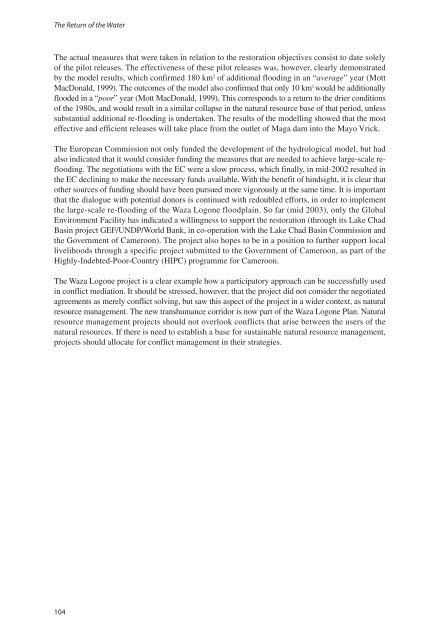The return of the water - IUCN
The return of the water - IUCN
The return of the water - IUCN
You also want an ePaper? Increase the reach of your titles
YUMPU automatically turns print PDFs into web optimized ePapers that Google loves.
<strong>The</strong> Return <strong>of</strong> <strong>the</strong> Water<br />
<strong>The</strong> actual measures that were taken in relation to <strong>the</strong> restoration objectives consist to date solely<br />
<strong>of</strong> <strong>the</strong> pilot releases. <strong>The</strong> effectiveness <strong>of</strong> <strong>the</strong>se pilot releases was, however, clearly demonstrated<br />
by <strong>the</strong> model results, which confirmed 180 km 2 <strong>of</strong> additional flooding in an “average” year (Mott<br />
MacDonald, 1999). <strong>The</strong> outcomes <strong>of</strong> <strong>the</strong> model also confirmed that only 10 km 2 would be additionally<br />
flooded in a “poor”year (Mott MacDonald, 1999). This corresponds to a <strong>return</strong> to <strong>the</strong> drier conditions<br />
<strong>of</strong> <strong>the</strong> 1980s, and would result in a similar collapse in <strong>the</strong> natural resource base <strong>of</strong> that period, unless<br />
substantial additional re-flooding is undertaken. <strong>The</strong> results <strong>of</strong> <strong>the</strong> modelling showed that <strong>the</strong> most<br />
effective and efficient releases will take place from <strong>the</strong> outlet <strong>of</strong> Maga dam into <strong>the</strong> Mayo Vrick.<br />
<strong>The</strong> European Commission not only funded <strong>the</strong> development <strong>of</strong> <strong>the</strong> hydrological model, but had<br />
also indicated that it would consider funding <strong>the</strong> measures that are needed to achieve large-scale reflooding.<br />
<strong>The</strong> negotiations with <strong>the</strong> EC were a slow process, which finally, in mid-2002 resulted in<br />
<strong>the</strong> EC declining to make <strong>the</strong> necessary funds available. With <strong>the</strong> benefit <strong>of</strong> hindsight, it is clear that<br />
o<strong>the</strong>r sources <strong>of</strong> funding should have been pursued more vigorously at <strong>the</strong> same time. It is important<br />
that <strong>the</strong> dialogue with potential donors is continued with redoubled efforts, in order to implement<br />
<strong>the</strong> large-scale re-flooding <strong>of</strong> <strong>the</strong> Waza Logone floodplain. So far (mid 2003), only <strong>the</strong> Global<br />
Environment Facility has indicated a willingness to support <strong>the</strong> restoration (through its Lake Chad<br />
Basin project GEF/UNDP/World Bank, in co-operation with <strong>the</strong> Lake Chad Basin Commission and<br />
<strong>the</strong> Government <strong>of</strong> Cameroon). <strong>The</strong> project also hopes to be in a position to fur<strong>the</strong>r support local<br />
livelihoods through a specific project submitted to <strong>the</strong> Government <strong>of</strong> Cameroon, as part <strong>of</strong> <strong>the</strong><br />
Highly-Indebted-Poor-Country (HIPC) programme for Cameroon.<br />
<strong>The</strong> Waza Logone project is a clear example how a participatory approach can be successfully used<br />
in conflict mediation. It should be stressed, however, that <strong>the</strong> project did not consider <strong>the</strong> negotiated<br />
agreements as merely conflict solving, but saw this aspect <strong>of</strong> <strong>the</strong> project in a wider context, as natural<br />
resource management. <strong>The</strong> new transhumance corridor is now part <strong>of</strong> <strong>the</strong> Waza Logone Plan. Natural<br />
resource management projects should not overlook conflicts that arise between <strong>the</strong> users <strong>of</strong> <strong>the</strong><br />
natural resources. If <strong>the</strong>re is need to establish a base for sustainable natural resource management,<br />
projects should allocate for conflict management in <strong>the</strong>ir strategies.<br />
104












